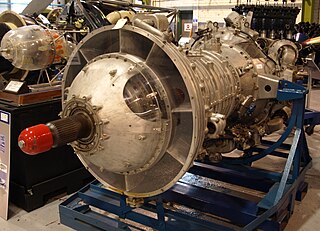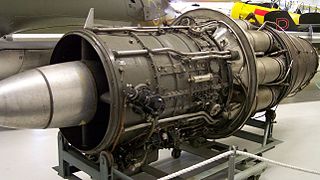
The Rolls-Royce RB.44 Tay was a British turbojet engine of the 1940s, an enlarged version of the Rolls-Royce Nene designed at the request of Pratt & Whitney. It saw no use by British production aircraft but the design was licence built by Pratt & Whitney as the J48, and by Hispano-Suiza as the Verdon.

The Rolls-Royce RB.41 Nene is a 1940s British centrifugal compressor turbojet engine. The Nene was a complete redesign, rather than a scaled-up Rolls-Royce Derwent with a design target of 5,000 lbf (22 kN), making it the most powerful engine of its era. It was Rolls-Royce's third jet engine to enter production, and first ran less than 6 months from the start of design. It was named after the River Nene in keeping with the company's tradition of naming its jet engines after rivers.

Bristol Siddeley Engines Ltd (BSEL) was a British aero engine manufacturer. The company was formed in 1959 by a merger of Bristol Aero-Engines Limited and Armstrong Siddeley Motors Limited. In 1961 the company was expanded by the purchase of the de Havilland Engine Company and the engine division of Blackburn Aircraft. Bristol Siddeley was purchased by Rolls-Royce Limited in 1966.

The Rolls-Royce Avon was the first axial flow jet engine designed and produced by Rolls-Royce. Introduced in 1950, the engine went on to become one of their most successful post-World War II engine designs. It was used in a wide variety of aircraft, both military and civilian, as well as versions for stationary and maritime power.

The Rolls-Royce RB.37 Derwent is a 1940s British centrifugal compressor turbojet engine, the second Rolls-Royce jet engine to enter production. Essentially an improved version of the Rolls-Royce Welland, itself a renamed version of Frank Whittle's Power Jets W.2B, Rolls inherited the Derwent design from Rover when they took over their jet engine development in 1943. Performance over the Welland was somewhat increased and reliability dramatically improved, making the Derwent the chosen engine for the Gloster Meteor and many other post-World War II British jet designs.

The Rolls-Royce RB.39 Clyde was Rolls-Royce's first purpose-designed turboprop engine and the first turboprop engine to pass its civil and military type-tests.

The Pratt & Whitney J52 is an axial-flow dual-spool turbojet engine originally designed for the United States Navy, in the 40 kN class. It powered the A-6 Intruder and the AGM-28 Hound Dog cruise missile. As of 2021 the engine was still in use in models of the A-4 Skyhawk.

The Lyulka AL-7 was a turbojet designed by Arkhip Mikhailovich Lyulka and produced by his Lyulka design bureau. The engine was produced between 1954 and 1970.

The Klimov VK-1 was the first Soviet jet engine to see significant production. It was developed by Vladimir Yakovlevich Klimov and first produced by the GAZ 116 works. Derived from the Rolls-Royce Nene, the engine was also built under licence in China as the Wopen WP-5.

The de Havilland PS.23 or PS.52 Gyron, originally the Halford H-4, was Frank Halford's last turbojet design while working for de Havilland. Intended to outpower any design then under construction, the Gyron was the most powerful engine of its era, producing 20,000 lbf (89 kN) "dry", and 27,000 lbf (120 kN) with afterburner. The design proved too powerful for contemporary aircraft designs and saw no production use. It was later scaled down to 45% of its original size to produce the de Havilland Gyron Junior, which was somewhat more successful.

The Bristol Orion aero engine was a two-shaft turboprop intended for use in later marks of the Bristol Britannia and the Canadair CL-44. Although the engine was built and underwent a development program, the BE.25 Orion project was cancelled in 1958 by the British Ministry of Supply in favour of the Rolls-Royce Tyne. In addition, interest in turboprop-powered aircraft was beginning to wane, because of the successful introduction of the Boeing 707 and Douglas DC-8 jetliners into airline service.
The Rolls-Royce/JAEC RJ500 was a 20,000 lbf (89 kN) civil turbofan which Rolls-Royce and the Japanese Aero Engine Corporation (JAEC) consortium hoped to develop for aircraft like the Boeing 737-300 and the McDonnell Douglas MD-80.

The Rolls-Royce RB.401 was a British two-spool business jet engine which Rolls-Royce started to develop in the mid-1970s as a replacement for the Viper. RB.401-06 prototype engines were already being manufactured when a decision to develop the higher thrust RB.401-07 was taken.

The Bristol Siddeley BS.100 is a British twin-spool, vectored thrust, turbofan aero engine that first ran in 1960. The engine was designed and built in limited numbers by Bristol Siddeley Engines Limited. The project was cancelled in early 1965.

The Rolls-Royce RB.50 Trent was the first Rolls-Royce turboprop engine.

The Rolls-Royce RB.108 was a British jet engine designed in the mid-1950s by Rolls-Royce specifically for use as a VTOL lift engine. It was also used to provide horizontal thrust in the Short SC.1.

The Rolls-Royce RB.162 was a simply constructed and lightweight British turbojet engine produced by Rolls-Royce Limited. Developed in the early 1960s, it was specially designed for use as a lift engine for VTOL aircraft but was also used in a later variant of the Hawker Siddeley Trident airliner as an auxiliary boost engine. A smaller related variant, the RB.181 remained a design project only, as did a turbofan version designated RB.175.

The Rolls-Royce RB.141 Medway was a large low-bypass turbofan engine designed, manufactured and tested in prototype form by Rolls-Royce in the early-1960s. The project was cancelled due to changes in market requirements that also led to the development and production of the smaller but similar Rolls-Royce Spey, and the cancellation of the Armstrong Whitworth AW.681 military transport aircraft project.

The Rolls-Royce RB.145 was a British jet engine designed in the early-1960s by Rolls-Royce for use as a lightweight VTOL lift and cruise engine. Developed from the Rolls-Royce RB108 the RB.145 featured more accessories and a higher thrust rating. Six engines developed by MAN Turbo were fitted to the first prototype of the EWR VJ 101 experimental German fighter aircraft, achieving supersonic flight by July 1964.

The STAL Dovern was a Swedish turbojet design of the early 1950s, named after a lake in Finspång municipality in Östergötland, Sweden. Intended to power the Saab 35 Draken, this aircraft was powered by the Rolls-Royce Avon instead. The Dovern did not enter production.



















